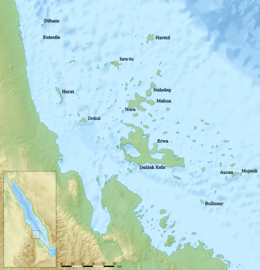Dahlak Archipelago
The Dahlak Archipelago is an island group located in the Red Sea near Massawa, Eritrea. It consists of two large and 124 small islands. The pearl fisheries of the archipelago have been famous since Roman times and still produce a substantial number of pearls.[1]
 | |
 | |
| Geography | |
|---|---|
| Adjacent bodies of water | Red Sea |
| Major islands | Dahlak Kebir, Dhuladhiya, Dissei, Dohul (Dehil), Erwa |
| Demographics | |
| Population | c. 3000 |
| Languages | Dahalik |
Geography
Only four of the islands are permanently inhabited, of which Dahlak Kebir is the largest and most populated. Other islands of the archipelago are Dhuladhiya, Dissei, Dohul (Dehil), Erwa, Harat, Harmil, Isra-Tu, Nahaleg, Nakura, Nora (Norah) and Shumma, although only Nora and Dohul are permanently inhabited, besides the main island. The islands are home to a diverse marine life and sea-birds, and attract an increasing number of tourists. Residents of the archipelago speak Dahlik, and maintain a traditional way of life including fishing and herding goats and camels. The islands can be reached by boat from Massawa and are popular with scuba divers and snorkellers.[2]
History
_p2.937_DHALAC_EL_KEBEER.jpg)
G.W.B. Huntingford has identified with the Dahlak archipelago a group of islands near Adulis called "Alalaiou" in the Periplus of the Erythraean Sea which were a source of tortoise shell. According to Edward Ullendorff, the Dahlak islanders were amongst the first in the Horn of Africa to embrace Islam, and a number of tombstones in Kufic script attest to this early connection.[2]
In the 7th century, an independent Muslim state emerged in the archipelago. However, it was subsequently conquered by Yemen, then intermittently by the Kingdom of Medri Bahri (Land of the Sea). In 1517 the Ottoman Turks conquered the islands and placed them under the rule of the Pasha at Suakin as part of the province of Habesh.[2]
The Italian colony of Eritrea, formed in 1890, included the archipelago. However, during this time the islands were home to little except the Nocra prison camp operated by the Italian colonial forces.[2]
After Ethiopia allied itself with the Soviet Union during the Cold War, following the rise of the Derg, the Dahlak Archipelago was the location of a Soviet Navy base.[3] In 1990, Ethiopia lost control of the Dahlak Archipelago and the northern Eritrean coast to the Eritrean independence movement (EPLF) and by 1991 Ethiopia had lost control of all of Eritrea.[2] Following the international recognition of Eritrean independence in 1993, the Dahlak Archipelago became a part of Eritrea.[4]
Ecology
Some of the islands are fringed with mangroves and others with salt brush scrub. The coral reefs and shoals that surround the islands are rich in marine life, and many sea birds visit the area. Dolphins, dugongs, sharks and turtles can be seen as well as a great variety of invertebrates.[2]
See also
- Dahlak Marine National Park
- Dahalik languages
References
- "Eritrea's Dahlak Archipelago Islands are so remote, there's almost no tourism". 2 June 2019.
- "The Dahlak Archipelago". Eritrea.be. Archived from the original on 30 November 2016. Retrieved 24 November 2016.
- "Ethiopia: The Armed Forces". Archived from the original on 24 December 2007. Retrieved 25 October 2006.
- Harper, Mary (24 May 2016). "Eritrea celebrates 25 years of independence after war with Ethiopia". BBC News. Archived from the original on 15 September 2016. Retrieved 24 November 2016.
External links
- Dahlak – Reef pearls of the Red Sea – Dahlak Islands informative site